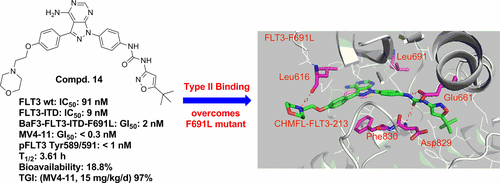当前位置:
X-MOL 学术
›
J. Med. Chem.
›
论文详情
Our official English website, www.x-mol.net, welcomes your
feedback! (Note: you will need to create a separate account there.)
Discovery of 1-(4-(4-Amino-3-(4-(2-morpholinoethoxy)phenyl)-1H-pyrazolo[3,4-d]pyrimidin-1-yl)phenyl)-3-(5-(tert-butyl)isoxazol-3-yl)urea (CHMFL-FLT3-213) as a Highly Potent Type II FLT3 Kinase Inhibitor Capable of Overcoming a Variety of FLT3 Kinase Mutants in FLT3-ITD Positive AML
Journal of Medicinal Chemistry ( IF 6.8 ) Pub Date : 2017-10-17 00:00:00 , DOI: 10.1021/acs.jmedchem.7b00840 Aoli Wang 1, 2 , Xixiang Li 1, 2 , Cheng Chen 1, 3 , Hong Wu 1, 2 , Ziping Qi 1, 2 , Chen Hu 1, 3 , Kailin Yu 1, 3 , Jiaxin Wu 1, 3 , Juan Liu 4 , Xiaochuan Liu 1, 2 , Zhenquan Hu 1, 2 , Wei Wang 1, 2 , Wenliang Wang 1, 3 , Wenchao Wang 1, 2 , Li Wang 1, 3 , Beilei Wang 1, 3 , Qingwang Liu 4 , Lili Li 5 , Jian Ge 5 , Tao Ren 4 , Shanchun Zhang 6 , Ruixiang Xia 5 , Jing Liu 1, 2 , Qingsong Liu 1, 2, 3, 4
Journal of Medicinal Chemistry ( IF 6.8 ) Pub Date : 2017-10-17 00:00:00 , DOI: 10.1021/acs.jmedchem.7b00840 Aoli Wang 1, 2 , Xixiang Li 1, 2 , Cheng Chen 1, 3 , Hong Wu 1, 2 , Ziping Qi 1, 2 , Chen Hu 1, 3 , Kailin Yu 1, 3 , Jiaxin Wu 1, 3 , Juan Liu 4 , Xiaochuan Liu 1, 2 , Zhenquan Hu 1, 2 , Wei Wang 1, 2 , Wenliang Wang 1, 3 , Wenchao Wang 1, 2 , Li Wang 1, 3 , Beilei Wang 1, 3 , Qingwang Liu 4 , Lili Li 5 , Jian Ge 5 , Tao Ren 4 , Shanchun Zhang 6 , Ruixiang Xia 5 , Jing Liu 1, 2 , Qingsong Liu 1, 2, 3, 4
Affiliation

|
FLT3-ITD mutant has been observed in about 30% of AML patients and extensively studied as a drug discovery target. On the basis of our previous study that ibrutinib (9) exhibited selective and moderate inhibitory activity against FLT3-ITD positive AML cells, through a structure-guided drug design approach, we have discovered a new type II FLT3 kinase inhibitor, compound 14 (CHMFL-FLT3-213), which exhibited highly potent inhibitory effects against FLT3-ITD mutant and associated oncogenic mutations (including FLT3-D835Y/H/V, FLT3-ITD-D835Y/I/N/A/G/Del, and FLT3-ITD-F691L). In the cellular context 14 strongly affected FLT3-ITD mediated signaling pathways and induced apoptosis by arresting cell cycle into G0/G1 phase. In the in vivo studies 14 demonstrated an acceptable bioavailability (F = 19%) and significantly suppressed the tumor growth in MV4-11 cell inoculated xenograft model (15 mg kg–1 day–1, TGI = 97%) without exhibiting obvious toxicity. Compound 14 might be a potential drug candidate for FLT3-ITD positive AML.
中文翻译:

1-(4-(4-氨基-3-(4-(2-吗啉代乙氧基)苯基)-1 H-吡唑并[3,4- d ]嘧啶-1-基)苯基)-3-(5-的发现(叔丁基)异恶唑-3-基)脲(CHMFL-FLT3-213)作为高强度的II型FLT3激酶抑制剂,能够克服FLT3-ITD阳性AML中的各种FLT3激酶突变体
已经在大约30%的AML患者中观察到了FLT3-ITD突变体,并将其作为药物发现靶标进行了广泛的研究。在我们先前的研究中,依鲁替尼(9)对FLT3-ITD阳性AML细胞表现出选择性和中等抑制活性,通过结构指导的药物设计方法,我们发现了一种新型的II型FLT3激酶抑制剂化合物14(CHMFL -FLT3-213),对FLT3-ITD突变体和相关的致癌突变(包括FLT3-D835Y / H / V,FLT3-ITD-D835Y / I / N / A / G / Del和FLT3- ITD-F691L)。在细胞环境中14强烈影响FLT3-ITD介导的信号通路,并通过将细胞周期阻滞到G0 / G1期诱导细胞凋亡。体内研究14在已接种MV4-11细胞的异种移植模型(15 mg kg –1天–1,TGI = 97%)中显示出可接受的生物利用度(F = 19%)并显着抑制了肿瘤的生长,而没有表现出明显的毒性。化合物14可能是FLT3-ITD阳性AML的潜在候选药物。
更新日期:2017-10-17
中文翻译:

1-(4-(4-氨基-3-(4-(2-吗啉代乙氧基)苯基)-1 H-吡唑并[3,4- d ]嘧啶-1-基)苯基)-3-(5-的发现(叔丁基)异恶唑-3-基)脲(CHMFL-FLT3-213)作为高强度的II型FLT3激酶抑制剂,能够克服FLT3-ITD阳性AML中的各种FLT3激酶突变体
已经在大约30%的AML患者中观察到了FLT3-ITD突变体,并将其作为药物发现靶标进行了广泛的研究。在我们先前的研究中,依鲁替尼(9)对FLT3-ITD阳性AML细胞表现出选择性和中等抑制活性,通过结构指导的药物设计方法,我们发现了一种新型的II型FLT3激酶抑制剂化合物14(CHMFL -FLT3-213),对FLT3-ITD突变体和相关的致癌突变(包括FLT3-D835Y / H / V,FLT3-ITD-D835Y / I / N / A / G / Del和FLT3- ITD-F691L)。在细胞环境中14强烈影响FLT3-ITD介导的信号通路,并通过将细胞周期阻滞到G0 / G1期诱导细胞凋亡。体内研究14在已接种MV4-11细胞的异种移植模型(15 mg kg –1天–1,TGI = 97%)中显示出可接受的生物利用度(F = 19%)并显着抑制了肿瘤的生长,而没有表现出明显的毒性。化合物14可能是FLT3-ITD阳性AML的潜在候选药物。











































 京公网安备 11010802027423号
京公网安备 11010802027423号